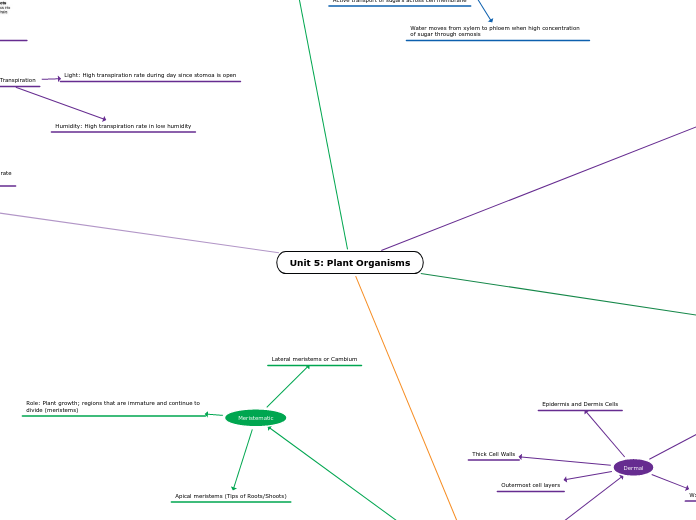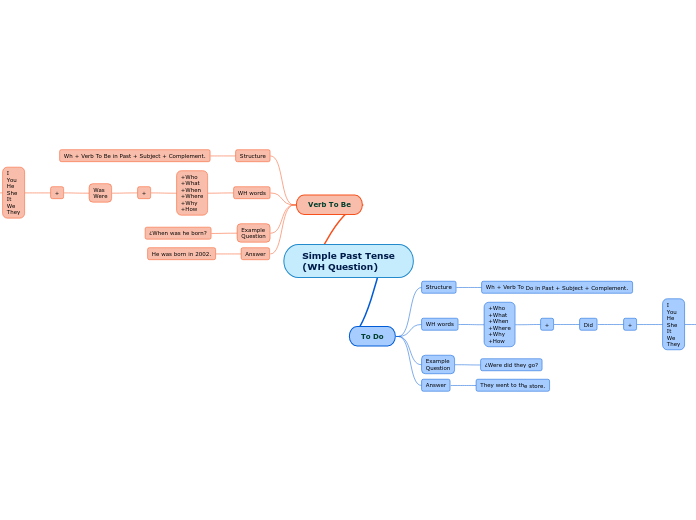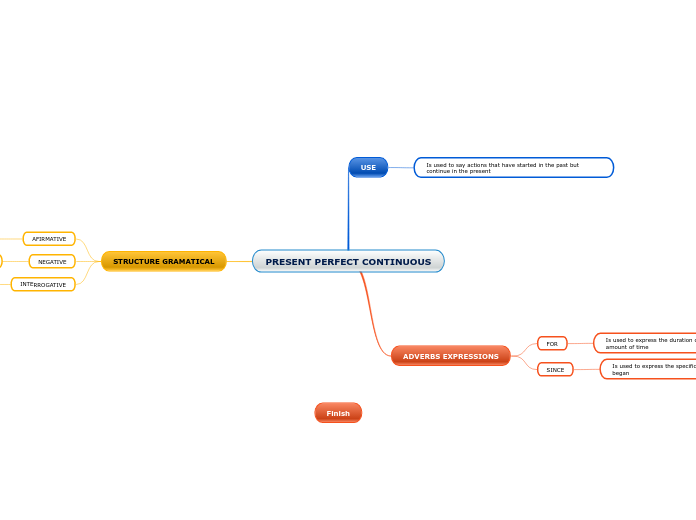Unit 5: Plant Organisms
Plant Transportation
Transportation of Water/Nutrients
3. Transport into Leaves
Leaves are main driving force of xylem upward
Transpiration
Factors Affect Transpiration
Number of Stomata per Leaf Surface Area: More stomata = Higher transpiration rate
Wind – High transpiration rate
in high winds
Humidity: High transpiration rate in low humidity
Light: High transpiration rate during day since stomoa is open
Temperature: High transpiration rate in high temperature
Evaporation of water through the stomata of plant leaves
2. Transport into Stem
Xylem sap rises due to root pressure and capillary action
Capillary Action: Water rise because of attractive forces between water molecules and side of wall
Root pressure: Osmotic force pushes xylem sap upward
Water molecules and dissolved nutrients called xylem sap
1. Roots absorb nutrient/water
Nutrients (Active Transport)
From low concentration (outside cell) to higher concentration (inside cell)
Water (Osmosis)
Water moves to vascular cylinder
Cytoplasm has less water than soil
Root Hairs
Form symbiotic association with fungi (mycorrhizae)
Increase SA to absorb more nutrients/water
Transportation of Sugars
3. From phloem cells to sink cells
Water re-circulated into xylem
Passive transport: High concentration of sugar in phloem, low in sink
2. Through Pholem
Not Well Understood
Translocation moves sugars from phloem cell to phloem cell
1. Source to Pholem
Water moves from xylem to phloem when high concentration of sugar through osmosis
Active transport of sugars across cell membrane
About transportation
Sugars can move up/down (Nutrients moves only up)
Sink: Cells with low concentration of sugars
Source: Cells with high concentration of sugars
Vascular Cylinder
Phloem
Sieve tubes
Companion cells that direct activities and supply nutrients
Between are sieve plates (large pores to facilitate transport)
Long, hollow tubes
Transports sugar through the plant
Living Tissue
Xylem
Types of Xylem
Vessel Elements:long, wide; joined together; more efficient
Trachiod: Long,Narrow; Trapid at ends
What is it?
Long, hollow tubes formed by non-living cells
Transports water/minerals from roots to stem/leaves
Reproduction
Sexual Reproduction
Pollen (male gamete) enters ovary (female gamete) and fertilizes into a seed
Asexual Reproduction
Cutting: part of plant falls off
Grafting: Combine several varieties of fruit
Runners: Drops new shoots into the ground and establishing new roots
Plant Body
Types of Plants
Dicotyledons (Dicots) (Oak trees, dandelions, canola)
Monocotyledons (Monocots) (Orchids, grass, lilies)
Flowers
Structure of Flower
Pistil: Female Reproductive Organ
Ovary:Contains ovule (female gamete)
Stigma: Sticky tip to collect pollen grain
Stamen: Male Reproductive Organ
Anther: Produces pollen grain (Male Gametes)
Filament:Connects Anther to flower
Petals: Colourful to attract pollinators
Sepals:Covers and protect flower buds before blossom opens
Dicot: Multiples of 4 or 5 petals
Monocot: Multiples of 3 petals
Leaves
Types of leaves
Leaf Vein Structure
Monocots: Parallel, Leaf sheet
Dicots: Branching, Petiole
Leaf Shape
Gas exchange
Photosynthesis
Defense
Internal Structure
Guard cells: control opening and closing of stoma
Stoma:gas passes in or out
Mesophyll cells (middle): contain chloroplast
Spongy: loosely packed, loosely packed for gas exchange, bottom layer
Paliasids:closely packed, upper layer
Epidermal cells (outside): covered in waxy cuticle
Seeds
Germination (Development of seed)
Dormancy – resting period
Absorption of water by the seed
Embryo releases growth hormone
Triggers cotyledons to convert starch to maltose
Maltose is used for cellular respiration
Sugar content is increased, causing more water to be absorbed
Seed coat softens and embryo emerges
Conditions for Germination
Light: For photosynthesis
Oxygen: to carry out cellular respiration
Temperature: To activate enzymes
Moisture: After heavy rain
Seed Dispersal
Propelled by plant
Carried through wind/water
Fruit (through digestive tract)
Stick to Animals
Structure of Seed
Endosperm: Nutrient rich, food for embryo
Seed Coat: Tough coat for protection
Function:provides nutrients to embryo and becomes first leaf
Dicots: Two seeded leaf
Monocots: One seed leaf
Roots
Root Structure
Vascular cylinder: Contains plants conducting tissues
(xylem and phloem)
Dicot Vascular Cylinder V.S Monocot Vascular Cylinder
Endodermis: Wax layer;Separates cortex and vascular cylinder
Root Hairs: Increase SA to absorb more nutrients
Epidermis: Middle cell layer, Stores starch
Epidermis: Outer layer, Protects inside/absorb nutrients
Types of roots
Taproots: Found in dicots
One thick, long, primary root in the middle
Secondary roots branch from it
Fibrous Roots: Found in monocot
Roots of equal size extend laterally over an area
Transport water/nutrients to stem
Some Store Food
Absorb Water/Nutrients
Anchor Plant
Stems
Growth Rings
Summer Wood: thick walls, dark colour
Xylem produced slowly
Spring wood: thin walls; light colour
Xylem produced rapidly
Dicots V.S Monocots
Dicot: vascular bundles arranged in a ring (vascular cambium)
Monocot: vascular bundles scattered throughout stem
Types of Stems
Woody: Hard/tough (wood); last winter
Woody System: Dicots
Bark: Everything outside Vascular cambium (protection)
Heartwood: Olderer Xylem (support)
Sapwood: Younger Xylem (transport)
Vascular cambium: Allows for thicker stem growth
Herbaceous: Green/soft; don't last winter
Function
Specialized stems
"On Ground": Grow along soil
Bulbs: Tiny, underground stems
Tubers: Underground stems
Rhizomes: store wate/food to help survive winter
Raise/support leaves/reproductive organs
Transportation of nutrients/oxygen
Types of Cell Tissue
Meristematic
Role: Plant growth; regions that are immature and continue to divide (meristems)
Lateral meristems or Cambium
Apical meristems (Tips of Roots/Shoots)
Dermal
Wxy cuticle
Thick Cell Walls
Outermost cell layers
Role: Protection
Epidermis and Dermis Cells
Vascular
Role: Transport of nutrients and support
Phloem: Thin cell walls, living at maturity
Xylem: Thick cell walls, dead at maturity
Ground
Role: Cellular growth, Storage, Support/Protection
Sclerenchyma = lignin in cell walls/dead
Collenchyma = thick walled/living
Parenchyma = thin walled/living
Plant Responses
Plant Adaptations
Salt: Roots lose water to soil through osmosis
Halophytes Response: Pump salt to stems at tip of plant; sheds tips to remove salt
Halophytes Response: Specialized glands pump salt across leaf epidermis for rain to wash away
Drought: Less water taken in than used
Response: Stomata in pits surrounded by hairs
Response: Thick cuticle and epidermis
Response: Modified leaves (spines/needles)
Response: Fleshy stem/leaves (holds water)
Flooding: Lack of oxygen for cellular respiration
Response: Partial roots above ground
Rapid Plant Movement
Increases/decreases turgor pressure of the mesophyll cells
Caused by movement of water/ions in/out of cells
Quickly Reversable
Rapid movement in response to stimulus
Tropisms
What is it
Regulated by plant hormones
Causes plant to bend to stimulus
Small Responses
Types of Tropisms
Thigmotropism: Growth of plant in response to touch
Geotropism: Growth of plant in response to gravity
Phototropism: Growth of plant in response to light









